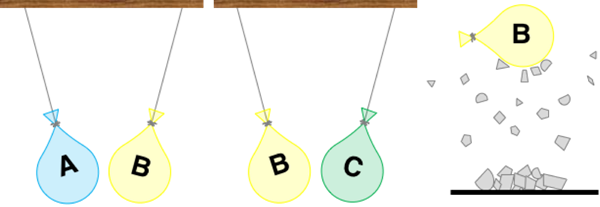It's All About Reasoning
Like a lot of our Concept Builders (but maybe more so with this one), you have some thinking and logical reasoning to do. The physics rules are straight-forward:
- opposites attract,
- likes repel, and
- charged and neutral attract.
But the application of these simple rules can get complicated. Get yourself organized and prepare to reason.
The Game Plan
This question is about Balloon C. The charge of Balloon A is stated. But Balloon C does not interact with Balloon A; it only interacts with Balloon B and with neutral paper bits. So you must first figure out what charge Balloon B has from its interaction with Balloon A and with the neutral paper bits. It would be best to look at the Paper Bits interaction first. That is discussed in the next section - What's With the Paper Bits? Then do some reasoning regarding what you know about Balloon B based on its interaction with Balloon A. Finally, use what information you learn about Balloon B to reason towards the possibilities for Balloon C. You got this!
What's With the Paper Bits?
Note that Balloon B and neutral paper bits attract. This interaction provides evidence that Balloon B is charged. A neutral balloon and neutral paper bits would not interact at all. By itself, this observation does not tell you what type of charge Balloon B has ... but only that it is charged and not neutral. You will need to use the other observation of Balloon B with Balloon A to reason towards what type of charge it has. But for now, you can rule out the neutral possibility.
Repulsion Provides Evidence for Clear Conclusions
There is only one reason for why two objects repel - they have the same type of charge. Neutral objects can never be involved in repulsion. But unfortunately none of the depictions represent repulsions. Balloons A and B attract and Balloons B and C attract. So prepare yourself for some uncertainty since only observations of repulsion are capable of narrowing down the field of possibilities. Those uncertainties are discussed in the next paragraph.
Careful about Attraction
Observe that Balloons A and B attract. There are two reasons for why two balloons attract. They could be oppositely charged or one could be charged and the other is neutral. The observed attraction of Balloons A and B by itself is not conclusive enough evidence that B is charged. But when you consider that B attracted the paper bits, you know for certain that it is charged. Thus, you know the charge of Balloon B - it is the opposite type of charge as Balloon A.
Now observe that Balloon B (whose charge you know) is attracting Balloon C. Since there are two reasons why objects attract, the observation of the B-C attraction leaves two possibilities for the charge state of balloon C. Apply the rules and answer the question. You got this!
